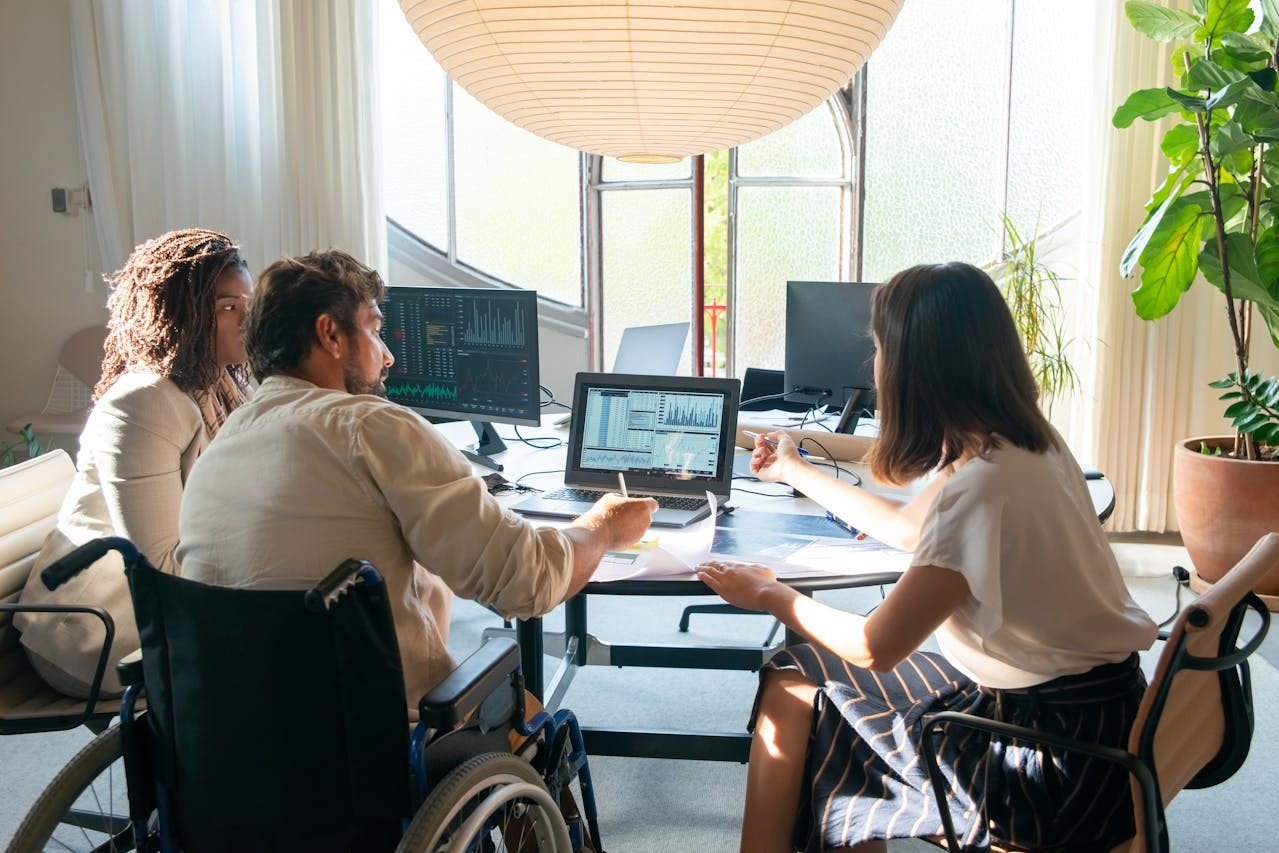The Lawyer's Mental Courtroom: Visualization Techniques That Build Unshakable Confidence
As I stood in front of the mirror in the courthouse bathroom, straightening my tie for the fifth time, I couldn't help but feel the weight of the upcoming trial. Despite my academic achievements and professional experience, the anxiety was palpable. I was about to face one of Baltimore City's most respected (and inflammatory) plaintiff's attorneys in my first solo jury trial.
The voice in my head was relentless: "You're too inexperienced. He'll eat you alive. The judges all respect him. You're going to embarrass yourself."
Sound familiar?
What happened next taught me a lesson about confidence that transformed my 40-year legal career—and it didn't come from additional case preparation or legal research.
The Confidence Crisis in Legal Practice
For attorneys at every level, self-doubt can be the most formidable opponent in the room. Even after winning a series of consecutive cases representing trucking companies, I still questioned my abilities. The external success never quite silenced the internal doubt.
Research shows that lawyers are particularly prone to stress-related illnesses, including burnout, insomnia, clinical depression, and substance abuse. In fact, a Hopkins study has shown that lawyers experience clinical depression at rates three times higher than other professionals: Mitchell, Mental Health in the Legal Profession, https://mcca.com/mcca-article/mental-health-in-the-legal-profession/. Self-doubt and impostor syndrome are challenges for many attorneys..
This mental battle has a measurable impact on performance. Our lack of confidence can contribute to poorer mediation and trial outcomes, as well as dissatisfaction and a lack of fulfillment in our profession.
The Mental Rehearsal Advantage
What transformed my practice wasn't more knowledge or experience—it was learning to harness the power of mental visualization. This practice empowered me, and it can empower you too, to take control of your thoughts and actions in high-pressure situations.
Visualization is more than positive thinking. It's a structured mental rehearsal process used by elite performers across domains—from Olympic athletes to surgeons. For lawyers, it means creating detailed mental images of successfully handling various professional situations before they occur.
This practice creates what psychologists refer to as "mental blueprints" for success. When you repeatedly visualize handling a cross-examination effectively or delivering a compelling closing argument, you're programming your brain with success patterns it can access during the actual event.
The results can be remarkable. Attorneys who practice regular visualization experience:
Significantly reduced pre-trial anxiety
Greater adaptability when unexpected challenges arise
Improved recall of key information under pressure
More authentic presence and jury connection
Faster recovery from setbacks during proceedings
Most importantly, visualization builds a foundation of confidence based not on wishful thinking but on systematically prepared mental pathways. This advantage becomes particularly evident in high-pressure situations, where emotional regulation is as important as legal knowledge.
The Neuroscience Behind Visualization
When I first heard about visualization techniques, I was skeptical. As attorneys, we're trained to be practical and evidence-based. But the research supporting visualization is compelling.
Neuroscience validates the concept that visualization improves actual performance. Mental rehearsal activates many of the same neural pathways as physical practice. This understanding can provide a sense of reassurance and confidence in the effectiveness of the technique, relieving any initial skepticism.
Your brain literally cannot distinguish between vividly imagining an experience and having it. When you visualize performing an action, your brain activates many of the same neural pathways as when you physically execute the task. This includes the motor cortex and related areas, which are responsible for planning and controlling movement. Brain imaging studies confirm that mental imagery triggers neural activity in regions associated with the intended action, effectively “priming” the brain for the real event. Repeated mental rehearsal strengthens these neural pathways, making the physical execution of the skill smoother and more accurate over time. The Power of Visualization: Imagining Yourself Doing Something Helps You Achieve Your Goal, https://rowancenterla.com/the-power-of-visualization-imagining-yourself-doing-something-helps-you-achieve-your-goal/.
The Three Core Visualization Techniques for Lawyers
Let's explore three specific visualization techniques that have proven particularly effective for attorneys. These approaches target the most common high-pressure situations in legal practice and can be customized to your particular challenges and practice area.
1. The Courtroom Preview
Before that intimidating first trial in Baltimore City, I should have known to walk through the entire experience mentally:
Creating the Scene
Picture yourself entering the courtroom. See the judge's bench, jury box, and counsel tables. Feel your shoes on the carpet. Hear the ambient sounds. Notice the temperature of the room. The more sensory details you include, the more effective the visualization becomes.
Rehearsing Key Moments
Imagine delivering your opening statement with clarity and conviction. See yourself making objections confidently and responding to opposing counsel's arguments with poise. Visualize the judge nodding in agreement with your reasoning. Pay attention to your breathing pattern, posture, and vocal tone in these mental rehearsals. When I coach attorneys on this technique, I recommend they visualize successful moments from previous cases and then transpose that same feeling of capability to the upcoming situation.
Preparing for Challenges
Anticipate difficult moments—a hostile witness, an unexpected ruling, or aggressive opposing counsel tactics. Then visualize yourself responding calmly and effectively, maintaining your composure and professional demeanor. This' stress inoculation' aspect of visualization is particularly valuable for newer attorneys, providing a sense of readiness and equipping you to handle unexpected situations.
2. The Client Confidence Builder
Client interactions often generate as much anxiety as courtroom appearances, especially when delivering difficult news or discussing sensitive matters. Many attorneys find that difficult client conversations can be even more stressful than courtroom appearances because of their unpredictable and personal nature.
Consultation Visualization
Before essential client meetings, picture the interaction unfolding successfully. See yourself explaining complex legal concepts clearly and effectively. Imagine the client nodding with understanding. Rehearse answering complex questions with confidence and clarity. In my practice, I found it helpful to visualize specific analogies or examples that I might use to illustrate complex legal concepts, mentally rehearsing not just what I would say but also how I would say it—the tone, pace, and level of detail that would resonate with that particular client.
Emotional Preparation
Visualize maintaining composure if the client becomes emotional or confrontational. See yourself responding with empathy while maintaining appropriate boundaries. Picture successfully guiding the conversation back to productive territory. This aspect of visualization is crucial for family law, criminal defense, and personal injury attorneys who frequently represent clients in emotionally distressing situations. The ability to remain present and composed during emotional conversations is a skill that can be strengthened through consistent mental rehearsal.
Outcome Clarity
Imagine ending the meeting with clear next steps and a satisfied client. See yourself shaking hands (or concluding a virtual meeting) with mutual understanding and trust established. Visualize the client expressing confidence in your representation. This "end-state" visualization serves two purposes: it provides a psychological target to aim for during the actual meeting, and it helps you clarify your objectives for the interaction before it begins.
3. The Professional Growth Accelerator
Many attorneys plateau in their careers, not because of legal skill deficits but because of discomfort with the professional growth aspects of practice. The same visualization techniques that enhance courtroom performance can dramatically accelerate career development when applied to leadership, business development, and professional visibility.
Leadership Visualization
Picture yourself confidently leading team meetings, providing clear direction, and inspiring colleagues. Imagine successfully handling disagreements and building consensus. In my years managing a law firm, I found that visualizing difficult conversations with partners or associates before they occurred significantly improved outcomes. The key is to visualize not just what you'll say but how you'll embody leadership presence—your posture, voice modulation, listening skills, and thoughtful response patterns.
Business Development
Visualize networking events where you connect authentically with potential clients and referral sources. See yourself articulating your value proposition clearly and confidently, following up afterward. Visualization can reduce social anxiety and improve interpersonal connections. For many attorneys, especially those with more analytical personalities, this technique transforms networking from a dreaded chore into a manageable professional skill.
Public Speaking
Before presentations or CLE events, mentally rehearse your delivery. See the audience engaged with your content. Imagine answering questions thoughtfully and receiving positive feedback. Elite speakers in every field use visualization to prepare. The technique is compelling when combined with physical rehearsal—visualize the presentation multiple times, then practice delivering it, then return to visualization to refine further. This creates a positive feedback loop between mental and physical practice that enhances both.
Implementing Mental Rehearsal in Your Practice
Establishing a consistent visualization practice doesn't require significant time investment, but it does demand intentionality and commitment. The following framework will help you integrate these techniques into your busy schedule for maximum benefit with minimal disruption.
The Optimal Visualization Routine
In my experience coaching attorneys, I have found that those who benefit most from visualization follow a consistent practice routine. The specifics matter—casual or inconsistent visualization yields minimal results, while structured practice creates transformative outcomes.
Timing
Dedicate 5-10 minutes daily to focused visualization, preferably at the same time each day. Many find that early morning or just before bed is most effective, as the mind is naturally more receptive at these times. During my most demanding trial periods, I found that even three minutes of focused visualization before entering the courtroom had a significant calming effect and performance boost.
Frequency
For specific events, such as court appearances or important meetings, begin visualizing 3-7 days in advance, with an additional focused session the morning of the event. This progressive approach builds mental familiarity that counteracts anxiety
Environment
Choose a quiet location free from distractions. Sitting comfortably with eyes closed facilitates deeper concentration. Some attorneys find soft background music helpful. Your physical state matters—good posture, relaxed breathing, and minimal muscle tension enhance visualization effectiveness. I recommend that attorneys create a specific "visualization spot" in their home or office to establish a conditioned response that quickly brings the mind into the proper state for effective mental rehearsal.
Combining Visualization with Physical Preparation
Visualization complements rather than replaces traditional preparation. After thoroughly researching a legal issue or preparing examination questions, visualize applying that knowledge successfully.
This integration builds success because the confidence you cultivate during visualization becomes linked to your actual performance.
Real-World Application: Overcoming Specific Challenges
The actual value of visualization becomes apparent when applied to the specific high-pressure situations attorneys face regularly. Let's examine how this technique addresses some of the most common challenges in legal practice, using practical examples from my own experience and those of attorneys I have coached.
First-Time Court Appearances
When I tried my first case against that renowned plaintiff's attorney in Baltimore City, he repeatedly made inflammatory statements and asked improper questions. I filed seven motions for a mistrial (none were granted), but ultimately secured a defense verdict.
Had I used visualization effectively, I would have:
Mentally rehearsed, maintaining composure despite provocations
Visualized myself making necessary objections without appearing flustered
Imagined connecting with the jury despite my opponent's tactics
Effective visualization for first-time appearances involves more than just rehearsing arguments; it also requires careful preparation. It means mentally preparing for the entire sensory experience—the formality, the acoustics, the proximity to opposing counsel, the feeling of all eyes on you. A comprehensive visualization practice would have helped me anticipate the psychological impact of these elements and prepare appropriate responses, reducing the cognitive load during the actual trial.
Facing Intimidating Opposing Counsel
Early in my career, I was often outmatched by attorneys with decades more experience. Visualization would have helped me see myself as an equal professional deserving of the same respect—something I only learned after a senior attorney told me: "Gary, you never have to call me Mister. I am an attorney, as you are."
When faced with intimidating opposing counsel, visualization becomes a powerful equalizing tool. By visualizing interactions with senior attorneys as conversations between equals, you can override the automatic deference patterns that may undermine your advocacy. I now teach newer attorneys to specifically visualize maintaining eye contact, steady vocal tone, and confident posture when interacting with more experienced opponents—physiological states that directly influence perceived authority and credibility.
Recovering from Setbacks
I once tried what seemed like a straightforward personal injury case where liability appeared clear. The defense barely contested liability—yet the jury returned a defense verdict. It was inexplicable and devastating.
Visualization helps process such setbacks by:
Mentally rehearsing returning to court with renewed confidence
Imagining discussing the case objectively with colleagues
Visualizing applying lessons learned to future cases
The resilience-building aspect of visualization is particularly valuable in legal practice, where setbacks are inevitable regardless of skill level. By visualizing yourself handling post-loss scenarios effectively, you're creating a mental resilience program that activates automatically when needed. Several attorneys I've coached have developed specific "recovery visualizations" they practice after significant setbacks—mental routines that help them process disappointment constructively and return to optimal performance more quickly.
Addressing Visualization Resistance
As a profession, lawyers tend to be skeptical of techniques that seem subjective or unquantifiable. Common objections include:
"I don't have time for this."
Consider that elite athletes and surgeons, professionals with equally demanding schedules, prioritize mental rehearsal because it improves performance efficiency. Five minutes of visualization can save hours of stress and second-guessing.
"This feels like wishful thinking."
Visualization isn't about denying challenges or ignoring preparation. It's about neurologically optimizing your readiness for those challenges through proven cognitive techniques.
"I can't visualize effectively."
Like any skill, visualization improves with practice. Start with simple scenarios and gradually increase complexity as your mental imagery becomes more vivid and controlled.
The Compound Effect: Building Lasting Confidence
The most potent aspect of visualization for lawyers is its cumulative effect. Each successful visualization builds upon previous ones, creating a reservoir of confidence that becomes increasingly resilient to setbacks.
This explains why many senior attorneys appear unflappable—they have built mental libraries of successful experiences, both real and visualized, that provide stability during challenging moments.
Measuring Success Beyond Feelings
While an improved emotional state is valuable, I encourage attorneys to track concrete metrics:
Speaking time in meetings and court
Willingness to take on challenging cases
Time spent ruminating on perceived failures
Client feedback on your confidence level
Reduction in physical stress symptoms
Beginning Your Visualization Practice
Start with this simple exercise:
Find a quiet place where you won't be disturbed for 5-10 minutes
Close your eyes and take three deep breaths
Imagine an upcoming professional situation in vivid detail
See yourself performing confidently and competently
Notice how your body feels during this visualization
If doubts arise, acknowledge them without judgment and return to the successful imagery
Conclude by imagining the positive outcome and the satisfaction you'll feel
Practice this daily for two weeks, then assess the impact on your actual performance and confidence levels.
Conclusion: The Case for Mental Rehearsal
Structured visualization stands as one of the most underutilized yet powerful tools available to legal professionals. By incorporating structured visualization into your professional routine, you can build the authentic confidence that distinguishes truly successful attorneys.
When I look back on my four decades in the legal profession, I recognize that the hours invested in transforming my mental approach yielded returns far exceeding those of any other professional development.
The attorneys I coach consistently report the same discovery: addressing their internal preparation unlocks potential that no amount of legal research or procedural mastery could achieve.
Perhaps most importantly, visualization provides a sustainable approach to legal excellence. Rather than exhausting yourself with ever-increasing hours of conventional preparation, mental rehearsal allows you to leverage your cognitive resources more efficiently. The result is not just better performance, but also greater resilience, satisfaction, and longevity in a profession often plagued by burnout.
Your inner critic may never disappear entirely, but with mental rehearsal, you can reduce its influence and increase your impact, both in the courtroom and in your life.
Would you like to discuss how to use visualization to build your self-confidence? You can schedule a courtesy call here.






